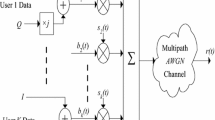Abstract
The Matched Filter and the Integrate-and-Dump circuit techniques are both attractive acquisition methods for CDMA systems. Acquisition using the matched filter technique has attracted considerable interest in recent years since it shows a better performance in the presence of Gaussian noise. On the other hand acquisition using an integrate-and-dump circuit is attractive because it is less complex to implement. However, the acquisition performance can be affected significantly by the channel characteristics. In this paper, a numerical method and a computer simulation have been developed in order to compare the two acquisition systems in different propagation environments. Results show that the acquisition using a matched filter is much faster than that using the integrate-and-dump circuit for the reception of spread-spectrum signals in the presence of Gaussian noise. However, in a multipath delay and fading environment, the results show that the mean acquisition time using the matched filter is not always faster than that using the integrate-and-dump circuit. The results show that it depends on the fading, the delay, the number of users and the signal-to-noise ratio.
Similar content being viewed by others
References
A.D. Whalen, "Detection of Signals in Noise", Academic Press, 1971.
J.W. Mark and I.F. Blake, "Rapid Acquisition Techniques in CDMA Spread-Spectrum System", IEE Proc., Vol. 131, Part F, pp. 223–232, 1984.
L.B. Milstein, J. Gevagiz and P.K. Das, "Rapid Acquisition for Direct Sequence Spread Spectrum Communication Using Parallel SAW Convolvers", IEEE Trans. Commun., Vol. COM-33, pp. 593–600, 1985.
A.K. El-Hakeem and S.A. Liebrecht, "A Multiprocessing Approach to Spread Spectrum Code Acquisition", Proc. IEEE MIL-COM '85, Boston, MA, pp. 18–24, October 1985.
E. Sourour and S.C. Gupta, "Direct-Sequence Spread-Spectrum Parallel Acquisition in a Fading Mobile Channel", IEEE Trans. Commun, Vol. COM-38, pp. 992–998, 1990.
E. Sourour and S.C. Gupta, "Direct-Sequence Spread-Spectrum Parallel Acquisition in Non-Selective and Frequency-Selective Rician Fading Channels", IEEE Selected Areas in Commun, Vol. SAC-10, pp. 553- 544, 1992.
D. Wilson, S.S. Rappaport and M.M. Vasudevan, "Rapid Acquisition Scheme for Spread-Spectrum Radio in Fading Environment", Proc IEE, Vol. 135, Part F, pp. 95–108, 1988.
Hu Lan and C.J. Burkley, "A New Channel Filter for CDMA Systems in Multipath Delay and Fading Environment", Proceedings VTC 1994, Stockholm, Sweden, pp. 573–577, 1994.
G.F. Sage, "Serial Synchronisation of Pseudonoise System", IEEE Trans. Commun., Vol. COM-13, pp. 123–127, 1964.
A. Polydoros and C.L.Weber, "A Unified Approach to Serial Search Spread-Spectrum Code Acquisition-Part I: General Theory", IEEE Trans. Commun., Vol. COM-32, pp. 542–560, 1984.
R.L. Pickholtz, D.L. Schilling and L.B. Milstein, "Theory of Spread-Spectrum Communications - A Tutorial", IEEE Trans. Commun., Vol. COM-30, pp. 855–884, 1982.
J.K. Holmes and C.C. Chen, "Acquisition Time Performance of PN Spread-Spectrum Systems", IEEE Trans. Commun., Vol. COM-25, pp. 778–783, 1977.
D.M. Dicarlo and C.L. Weber, "Statistical Performance of Single Dwell Serial Synchronisation Systems", IEEE Trans. Commun., Vol. COM-28, pp. 1382–1388, 1980.
P.M. Hopkins, "A Unified Analysis of Pseudonoise Synchronisation by Envelope Correlator", IEEE Trans. Commun., Vol. COM-25, pp. 770–773, 1977.
W.S.S Jibrail and A.-R.J. Houmadi, "Acquisition of Direct Sequence Spread-Spectrum Signals Using Sliding Correlators", Int. J. Electronics, Vol. 71, pp. 733–743, 1991.
Hu Lan and C.J. Burkley, "Fading Rate and Multipath Delay Effects on Signal Acquistion Using Sliding Correlation in a Multi-User Environment", Wireless Personal Communications, Vol. 2. pp. 235–244, 1995.
T.S. Rappaport, "Wireless Communications - Principles and Practice", Prentice-Hall, 1996.
Hu Lan and C.J. Burkley, "Improving the Performance of CDMA Systems in a Multipath Delay and Fading Environment", European Transactions on Telecommunications, Vol. 8. No. 3, 1997.
Hu Lan and C.J. Burkley, "Rapid Acquisition Schemes for CDMA Systems in a Multipath Delay and Fading Environment", Proc. IEEE ISSSTA, Oulu, Finland, pp. 593–597, July 1995.
W.H. Lam and P.S. Gaskell, "The Effect of Delay Spread on the BER Performance of Indoor Personal Communication Systems", 5th International Conference on Mobile Radio and Personal Communications, Coventry, U.K., pp. 107–111, December 1989.
Author information
Authors and Affiliations
Rights and permissions
About this article
Cite this article
Lan, H., Burkley, C. Comparison of the Acquisition Performance of the Matched Filter and Integrate-and-Dump Receivers in a Multipath Delay and Fading Environment. Wireless Personal Communications 10, 271–286 (1999). https://doi.org/10.1023/A:1018336130668
Issue Date:
DOI: https://doi.org/10.1023/A:1018336130668



